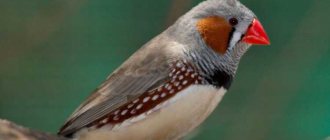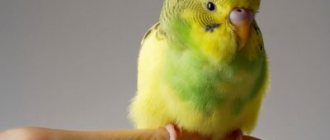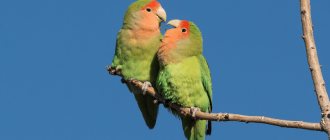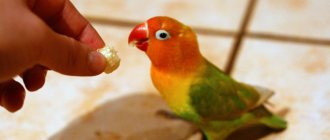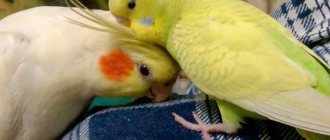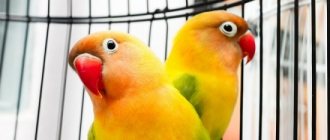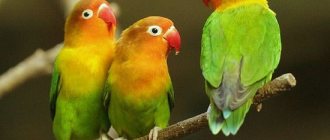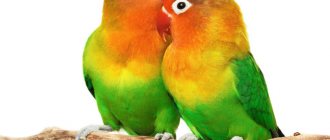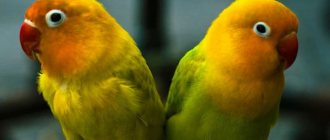The history of the appearance of lovebirds in cages
In the wild, lovebirds can be found in the forests of Africa and Madagascar. They live near water and lay eggs at the bottom of a hollow. They feed on berries and small seeds. They live in small flocks.
An adult bird will never become tame. Therefore, it is advisable to artificially feed them shortly before leaving the nest.
The bird was first brought to Europe in 1860. It was a pink-cheeked lovebird. After 9 years, the first offspring was obtained. Since 1927, Fischer's lovebirds and musky lovebirds have been kept in captivity. Additionally, birds were bred with blue, purple, white and yellow colors.
Lovebirds were first brought to Russia in 1970.
Native region or natural habitat
These parrots are native to a small region in northeastern Tanzania . This place is world famous for Lake Victoria, Serengeti National Park and the highest layered volcano, Kilimanjaro. Masked lovebirds can often be seen in small flocks near fresh water sources. They usually prefer dry areas with sparse vegetation near forested areas. Some populations have also been found for many years in Kenya and Burundi .
Appearance and description of lovebirds
Lovebirds are small parrots, about the size of a bullfinch. The length of their body is 10-17 cm, and all no more than 60 g. They have a bright color, with a predominant green color.
It is a myth that a bird dies alone. A lovebird at home can initially live alone or after parting with a second parrot. In this case, he requires more attention from the owners. These birds do not like loneliness.
I decided to have these birds at home because they are easy to train, are not afraid of hands or people, are extremely funny and do not require any special care. The only downside is that the bird does not speak. They can only reproduce a certain set of sounds.
Behavior and character traits
It is true that small birds are more energetic. This also applies to masked lovebirds. These funny little pets are full of energy and they are also very inquisitive. They will do everything possible to see what is in some hidden place that interests them. Most of the time they are just pure comedy. This makes masked lovebirds a lot of fun to watch. Parrots' health and happiness depend on social interaction. Make sure you spend plenty of time interacting and playing with your winged friend. Do not under any circumstances neglect communication with masked lovebirds! Then they will be truly happy.
Living conditions and care for lovebirds at home
To keep lovebirds at home, you should choose a bright, well-ventilated room, without drafts. There should be no windows or heating devices near the cage.
You cannot keep the cage on the floor. It is better to install it on a table, shelf or hang it from the ceiling.
Lovebirds love to chew on everything. The same applies to the cell. Therefore, its rods should not contain copper or zinc. These substances can cause poisoning. The minimum cage dimensions are 40/50/80 cm.
It should be equipped with:
1. Wooden perches. There should be 2-3 of them. Plastic options can lead to the formation of corns.
2. Feeders and drinkers.
3. Various toys. These should be swings, ladders and ropes.
Twice a week you should wash all the perches and rods with warm water and a toothbrush. The bottom of the cage should be dry with paper towels and organic sand.
Don't put newspapers down. Birds can chew them, which will lead to poisoning. The paper is changed when it gets dirty.
To live a full life, birds need to fly. It is better to let them out of the cage when you are at home. At the same time, all doors and windows must be closed so that the bird does not accidentally fly out into the street.
It is also worth covering the windows with curtains. This will protect the bird from colliding with the glass. You should not force parrots into a cage. You should wait until they want to come in or lure them in with treats.
Like all birds, the lovebird wakes up at dawn and goes to sleep after sunset. Therefore, late in the evening you need to cover the cage and not turn on loud music or TV. If the bird does not get enough sleep, it will be weak and passive.
Lovebirds love to splash in the water, so during hot weather they should put a bathing suit in their cage twice a week. After water procedures, make sure that the bird does not get sick. To do this, eliminate all drafts and turn on an infrared lamp next to the cage.
In winter, the bathing suit should be installed once a week. In order for the parrot to dry out as quickly as possible, you need to turn on the heater.
Advice! Never blow dry your bird. This will not only do her no good, but it will also frighten her.
Feeding lovebirds at home
In stores you can buy special food for medium and small parrots. They contain all the necessary ingredients. It's simple, nuts, oats and more.
During the molting period, additional supplements with vitamins and minerals should be given. You can also feed lovebirds at home with fresh vegetables and fruits, boiled egg whites and low-fat cottage cheese.
Greens must be present in the diet. Lovebirds can be given dill, dandelion leaves, lettuce and asparagus. They love to chew on the branches of fruit trees. Just pick them away from the roads.
You should not feed lovebirds avocados, mangoes and papaya. They contain oils that negatively affect the digestive system of birds.
For one adult bird, the norm per day is 2-4 tablespoons of feed. Grain mixtures fall asleep in the evening, and wet mixtures in the morning. The feeder should be changed as needed during the day. The bird cannot be allowed to starve. Even a short period of hunger can lead to her death.
Lovebird parrot - reviews about the breed
- + Leave a review
Leave a review Reset
Oxana
My husband brought two lovebirds, and then he regretted it. They litter a lot, they put the feeders at the bottom of the cage so that at least they wouldn’t litter so much. It doesn’t help with the constant flapping of their wings. But the screaming lasts all day. They’re not tame at all. They bite. I approached them this way and that, I wanted to make friends, they don’t accept them. For three years they got them, one recently died and got sick. They wrote that the second one wouldn’t survive separation, nothing like that and behaves the same without him. Constantly They fought, mated with each other, so it’s not even clear which of them was what gender. In general, they are stupid birds. A friend of mine has an ordinary parrot, and it’s tame and smart.
ayrat
Many people believe that they should only buy from breeders. Yes, I agree. But when buying, you need to take into account not only this factor. Perhaps due to an oversight, or perhaps deliberately, they may sell you a bird with a congenital abnormality of the foot at first glance and unnoticed (as recently happened with my purchase). Also, out of ignorance, they may sell you not a pure mask, but a hybrid of a mask and a fisher - it seems to be a mask, but for some reason the color on the head is not particularly black and the neck is not particularly yellow, but with an admixture of orange. This is what happened to me.
Helen
Good day to all! I have a lovebird, a girl, name is Richie. Kupia, when she was only six months old, amazed with her appearance, it takes a long time to tell, but the first six months were something... bites, bruises!!! I wanted to give it to good hands, but it’s surprising that as soon as I turned six months old. stopped biting. And now she is two years and 10 months old. She’s completely tame, a sweetheart... she loves to go for walks, she begs like hell... she loves it when I scratch her little head, her ears, her neck... she loves Varenets, I don’t know why, but she’s just thrilled... Now I can’t imagine what I wanted to give to someone... the sounds of course not like a nightingale... very different. She’s very curious, smart, and understands perfectly well that I’m in work clothes or at home... because I can chew on my home clothes, I let her... when she sits in the cage next to me and I’m working, she sits and makes a lot of different sounds, which surprises me! !! You just need to love and then understanding will come. Very independent, freedom-loving, but trusting and affectionate, my first parrot, and very beloved. By the way, I'm very jealous...
Anonymous613621
https://otzovik.com/review_2525563.html
Advantages:
- There are very few of them
Flaws:
- Do not list
Handsome, interesting, very lively, smart. A wild, frightened parrot, does not like to be touched, is aggressive, has a very loud squeal that is unpleasant to the ear, cannot be tamed in any way unless you feed it from childhood, gnaws everything, will turn your house into a gnawed house. The vile bird will gnaw the wallpaper, break the flowers. Don’t believe all these “optimists” who are fooled by buying birds and who pick out some merits about them.
SophiaDarling2001
https://otzovik.com/review_2584431.html
Advantages:
- Bright and cheerful
- beautiful.
Flaws:
- Tweets loudly
- need a pair
- litters a lot.
The lovebird is a bright tropical bird.
It would seem cheerful, beautiful, bright, at first glance anyone would want the same, but there is a problem:
- A lot of trash in the room
- tweets too loud
- you can’t keep him alone (lovebirds live in pairs)
If the children ask, then they won’t clean up after him or look after him (it gets boring quickly).
Well, as you look at it, for one it’s a joy, but for another it’s a nasty and annoying bird.
Zaika1707
https://otzovik.com/review_1102705.html
Advantages:
- Merry
- sociable
Flaws:
- Not discovered yet
We recently bought two green lovebirds, they are only 3 months old, but they are already larger in size than a wavy one, they have a very loud voice, our children really like them, especially when they chirp. We took home-bred chicks, hopefully they will be tamed quickly. It’s just that we can’t figure out where the boy is and where the girl is. And another question, if anyone knows, when they live as a couple, is it possible to teach them to talk or not.
Bulbyonochka
https://irecommend.ru/content/ochen-ne-sovetuyu-0
Advantages:
- beautiful
Flaws:
- a little aggressive
- noisy
Everything they say about lovebirds is true. A very noisy and aggressive parrot. When I was a teenager, I had a cockatiel, a very cheerful and cheerful parrot, very affectionate and talking. But one day a lovebird flew onto our balcony - it seemed small and cute. As it turned out, it was a girl. We sheltered her. She began to systematically “beat” my cockatiel, who was 3 times her size, screaming from morning to evening, and damaging furniture. Overall a VERY noisy and aggressive bird. If you've never had one, I don't recommend getting one - not every person can withstand SUCH noise! and she doesn’t shut up for a minute!!! I had to give it away
julija1985
https://otzovik.com/review_1071099.html
Advantages:
- cheerful character
- the ability of lovebirds to reproduce, songbirds
Flaws:
- These parrots are very destructive they chew everything
- pecks painfully
- very cocky
Parrots are considered smart birds, so breeding them is very profitable. Reproduction in lovebirds occurs in March-April. During this period, the birds should be released to fly around the room for several hours. The cage with the birds should be in the sun.
Flower Girl
https://irecommend.ru/content/ptitsy-sozdaniya-boga
The love for birds was passed on to me by inheritance. My grandfather simply adored birds, and in his youth he had his own dovecote. He talked a lot about his favorites, about their loyalty and intelligence. It happened that pigeons were stolen, but they always returned to their owners.
As a child, I even had an album in which I drew birds and pasted cuttings from magazines and newspapers. It was a gift for grandfather.
I grew up. But I always considered birds to be one of the most beautiful creatures on earth.
This is the second year that two lovebirds have been living with us. They don't have names. And I have no goal of taming those in whom the blood of freedom and independence flows. I just admire these beautiful bright birds. It is sometimes a pity that they are doomed to live in captivity, but they probably never knew any other life.
These birds have very loud voices. The first months were difficult to get used to, we were forced to wake up very early - the birds simply did not let us sleep. They talk louder than the TV! Over time, we got used to the noise, but the bird calls never let us forget about them.
Our parrots are ardent litter lovers. The area around the cage should be cleaned at least 2 times a day. With the same consistency, and maybe more often, you need to change the water in the drinking bowl and bathing basin.
At the bottom of the cage I pour special sand for birds (sold in the store). Newspapers and paper are destroyed by strong beaks within a couple of hours.
In addition, one of them was sick last year: he lost all his feathers and became bald. Thanks to treatment, he was able to get back on his feet. Now, I won’t even say which of them was bald.
In general, they are very funny and cheerful birds, but with their own characteristics.
Famouron
Advantages:
- Beautiful birds.
Flaws:
- Loud
- taciturn
- timid.
After listening to stories about smart, talking and tame parrots, I passionately wanted to have such a miracle. As a result, my wish was fulfilled and when I went to a pet store, the seller offered us such a parrot. I didn’t know anything about them before and was counting on a banal budgie, but the seller assured us that these were faithful parrots. A strange argument, but they bought it, selling at the same time their peace and a significant part of the nervous system.
So, the purchase was disappointing. The parrot turned out to be noisy, squeaked loudly and shrilly, very timid, it was impossible to accustom him to a hand, teach him to talk, and even more so. It turns out that this happens very rarely with this breed. They bought him a girlfriend, hoping that he would be quieter. Nothing like that: now they were screaming at both throats. In addition, the female began to beat him, even though she had laid several eggs.
I will never have parrots again. None.
xumuk032
https://otzovik.com/review_3022120.html
Advantages:
- funny
- smart
- active
Flaws:
- dirty
- voiced
Hello, dear readers!
A few months ago we became the happy owners of a pair of rosy-cheeked lovebirds. Let me make a reservation right away: I didn’t have any living creatures when I was a child. but I really wanted to. my wife had cats and budgies.
And so, we decided to get parrots. Both have a craving for living creatures. I didn’t want to have little birds (for some reason they seem like stupid birds to me) and opted for lovebirds.
It turned out that they are very funny, interesting and smart birds! Moreover, birds with character! Each individual has its own.
Of course, lovebirds (especially pink-cheeked ones) have some qualities that scare away some future owners - these are their ringing, piercing screams! There’s no escape here—they scream, really, piercingly. But it’s not so disgusting that you don’t want to start them.
Another “negative” trait is the ability to bite strongly when defending itself or its territory. The beak, although small, is very strong!
But these two minor troubles are more than compensated for by their irrepressible cheerfulness and activity! And also their behavior as a couple. You can watch all this almost endlessly! They know how to kiss and quarrel. And even fight. But they don’t quarrel and fight often and they don’t do it for long. In general, everything is like with people!
As I already wrote, the birds are very active and inquisitive. And smart too. They are relatively easy to train. They get used to people well. But they are almost unable to repeat human speech. There are cases, of course, but not often. And they speak very poorly.
Caring for these birds is not very difficult. All they need is a variety of food, a spacious cage and periodic walks around the room (they are flying birds - they need to stretch their wings)!
There are no big problems with the nutrition of lovebirds. They eat a lot of things, but the basis of their diet should be grain mixtures. I use the main RIO diet, as well as a sprouting mixture from the same manufacturer. They eat with pleasure. In addition to grains, birds need fruits, vegetables and minerals. They enjoy gnawing on branches of fruit trees.
Like many parrots, lovebirds are still piglets! They litter a lot and you need to be prepared for this too.
As a summary I can say the following. With proper maintenance and some sacrifices (on their part), birds bring more joy and positive emotions than negativity. But for this you need to love birds!
Unfusided
Advantages:
- color
- behavior
- care
Flaws:
- There is not
I adore various beautiful birds, the lovebird parrot is just like that. Beautiful bright color, easy to care for, sociable, ideal pet. I personally really like them.
The lovebird lives in Madagascar and Africa. The size of the birds is ideal for me, not huge and not small, sizes from 10 to 17 cm. Another thing I liked about this bird is that it gets used to its owner. The lovebird got its name from its way of life - they live in large flocks, in pairs, family birds. If a lovebird has found a mate, we can say with confidence that the couple remains faithful to each other throughout their lives. The colors of lovebirds are different and very bright, which is why I like them. They live quite a long time, 15-20 years. In its beauty and interesting social behavior it is superior to many birds. The downside of this bird is its character, it is very jealous and constantly needs attention. It is unnecessary to keep a lovebird in the same cage with other species of birds; it can injure its neighbor, regardless of the size of the bird. There are many types of lovebirds in nature. They cannot be trained; they can be taught to speak, but it is very long and difficult. Can learn 10-15 words. Care is simple, he needs a cage with accessories that he likes to use for walks. They scatter food around the cage like any other bird.
The food is simple, special food, fresh water and any greens. First, the greens need to be washed with water. You can give certain fruits and vegetables; a list of them can be found on the Internet. Vegetables or fruits cannot be given from dishes (sugar, salt, butter). You need to give branches of fruit trees to grind down your teeth. If you want to sleep well in the morning, you need to cover the bird with a cloth. I really like how the lovebird bathes, it’s a very funny process. They themselves love to swim and they need it especially during the breeding season. For the eggs to develop normally, there must be a lot of humidity during the breeding season, or the eggs will not develop normally. From personal experience I can say that there is no need to buy poultry in a store or market; find a normal distributor. There are no difficulties in caring for it, an excellent bird for the family and a friend, it lifts the spirits perfectly. It's funny to watch him.
Breeding lovebirds at home
Breeding lovebirds at home has a number of features. First, the bird should be put on a diet. The diet should include greens, rice porridge and sprouted grains.
Advice! Birds should not be allowed to breed during the molting period. It is advisable that a month pass after the change of plumage. During this time, the parrot will regain its strength.
Next, you should prepare building materials for the nest. To do this, tree branches are treated with boiling water. Building materials are located outside the cage; the female builds the nest herself.
During the breeding season, the behavior of the male changes. He becomes more aggressive and can attack his owners.
The female lays the first egg a week after mating. In total she will put aside from 4-8. The chicks appear after 20-26 days.
Breeding
The mating season of masked lovebirds occurs in spring and summer. Under natural conditions, parrots begin to build nests or look for a suitable hollow in advance. There the female lays eggs and incubates them for three weeks. She does not leave the clutch unattended for a minute, and at night the male helps ensure the safety of the future chicks.
Young individuals hatched from eggs open their eyes only after two weeks. Their body is covered with pinkish fluff. After six weeks, the chicks learn to fly. And after about fourteen days they become completely independent.
The masked lovebird is an active pet that does not let its owner get bored. However, this bird should not be owned by those who do not like loud noises or suffer from allergies to parrots.
Which type of lovebirds, in your opinion, is the most beautiful and most suitable for keeping in captivity? Share your point of view in the comments, and also join our VKontakte group.
Differences between male and female lovebirds
When buying a parrot, everyone has the same question: how to determine the sex of lovebirds at home?
In this species, the female is slightly larger than the male. She has a rounded head and beak. Males have an elongated skull with a flat top and a larger beak with a distinct groove.
Gender can also be determined by behavioral characteristics. Girls preen themselves more often, and boys try with all their might to win their favor. They feed the females and clean their feathers.
Varieties of lovebirds
The crown in popularity is held by the rosy-cheeked representative of lovebirds; some individuals have the ability to pronounce some words. Although they are not able to make speeches like their relatives, budgerigars or gray parrots, they can master a few simple phrases. But with the eccentricity of their character, they can outshine anyone; these conflicting birds, in an irritated state, are even capable of showing aggression and demonstrating their beak in action.
In total, lovebirds are divided into 9 species:
- mask;
- Fisher's lovebird;
- black-cheeked;
- strawberryhead;
- rosy-cheeked;
- black-winged;
- redface;
- Madagascar;
- necklace.
Bird breeders have managed to breed many different subspecies of these birds, which have noticeable differences in plumage color and require attention and care. In terms of plumage color, the male and female are practically the same.
Compatibility of lovebirds with other poultry and animals
It is better to keep only representatives of one species in a cage. They do not get along well with other animals. They attack, scream and may even pinch representatives of other species.
It is not recommended to hang a mirror in a cage. One of the pair can perceive the reflection as another parrot and take care of it. Some birds even fall in love with the reflection, and then, not receiving reciprocity, fall into melancholy.
Lovebird diseases at home and treatment methods
The main causes of lovebird diseases are improper care. For example, an intestinal infection develops from expired food and unsanitary conditions in the cage.
Colds can occur due to frequent drafts, and if parrots are not fed enough, they will develop vitamin deficiency.
It is also necessary to monitor the psychological state of pets. If you pay little attention to them, they will begin to feel depressed and pluck themselves.
Infectious diseases that birds can suffer from include psittacosis and salmonellosis. Parasitic diseases include knemidocoptic mange and helminthiasis.
In mild cases, the bird can heal on its own; in advanced cases, you should consult a veterinarian. Lack of medical care will lead to the death of the parrot.
In nurseries, chicks are vaccinated against a large number of diseases. At six months they are vaccinated against rabies.
